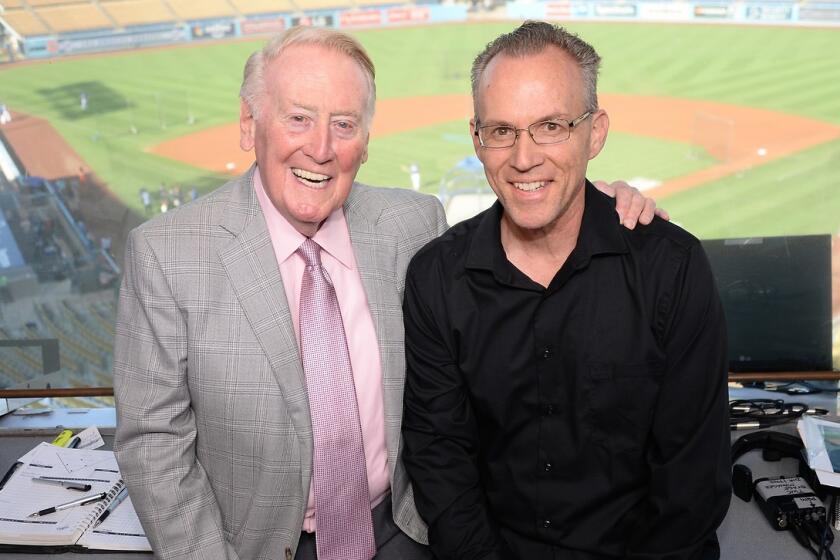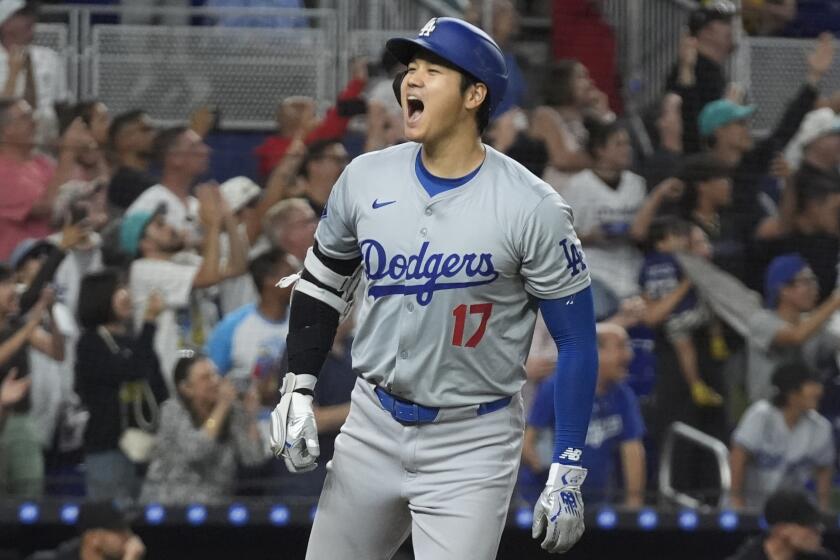
- Share via
The most valuable piece of memorabilia from the Dodgers’ World Series championship run is easily identified. It’s the baseball struck by Freddie Freeman that landed in the right-field pavilion in the 10th inning of Game 1, the first walk-off grand slam in fall classic history.
Auction experts estimate it would fetch more than $2 million, the value burnished by the Dodgers winning the five-game series over the New York Yankees and Freeman being named the most valuable player. The ball was scooped up by a 10-year-old diehard Dodgers fan, and he’s been floating on cloud nine ever since.
Yet many other items also have value, and there is no shortage of fans that would love nothing more than to own something authentic to forever remind them of the Dodgers’ first full-season championship since 1988.
A 10-year-old Dodgers fan believed he was getting out of class early to get braces removed. Instead, he attended the World Series and caught Freddie Freeman’s walk-off grand slam.
But first, the National Baseball Hall of Fame and Museum got a haul, coming away with enough Dodgers artifacts to outfit what promises to be a cool display in Cooperstown. David Kohler, president of SCP Auctions, said the collection would be worth “$100,000-plus” at auction and “will make a great display at the Hall of Fame.”
Following the 7-6 series-clinching victory in Game 5 Wednesday night at Yankee Stadium, the Dodgers donated the following:
- Spikes worn by Freeman in Game 1 and 2.
- Glove worn by Walker Buehler, who got the save in Game 5 two days after winning Game 3.
- Cap worn by manager Dave Roberts.
- Clayton Kershaw’s champagne-soaked championship cap.
- Batting gloves worn by Mookie Betts, who hit .290 with 16 runs batted in in the postseason.
- Jersey worn by Anthony Banda, who turned in scoreless relief appearances in each of the four World Series wins.
- Cap and chest protector worn by Will Smith, who caught the final strikeout of the World Series.
- A ball used during the ninth inning of Game 5.
- Max Muncy’s bat and batting gloves when he set a record by reaching base in 12 straight postseason games.
- Batting helmet worn by National League Championship Series Most Valuable Player Tommy Edman.
Mark Langill, the Dodgers staff historian since 1994, also will corral enough artifacts to create displays throughout the stadium. Langill works fast: The jersey Freeman wore when he hit the iconic Game 1 grand slam was already framed and hanging in a Dodger Stadium hallway during Game 2 the next day.
Mark Langill knows more about Dodger history than anyone, and that history is carrying him through the rocky ground where everything else is uncertain.
Players own everything in their locker, so the team or the Hall of Fame must get their permission to take clothing or gear. Langill said for the most part players and coaches are happy to donate something that will be displayed for fans to enjoy.
“There is a happy medium,” he said. “You have to respect what the players want.”
Langill is averse to displays loaded up with several baseballs, bats, caps and jerseys.
“You don’t want it to look like a sporting goods store,” he said.
Most everything from the clubhouse after a World Series win has value on the auction market. Players in all sports often sell championship memorabilia, usually after they retire.
Dodgers star Shohei Ohtani’s 50th home run ball sold at an auction for a record $4.4 million. Who gets that money? That’s still up to the courts to decide.
Occasionally they even plan ahead. Hall of Famer Gaylord Perry pitched a complete game for his 300th victory in 1982, and he changed his jersey after every inning, creating nine authentic artifacts he could peddle.
These days, Major League Baseball positions employees in each dugout to immediately authenticate everything from milestone baseballs to gear worn by players. When Walker Buehler struck out Alex Verdugo to end the World Series, Smith shoved the ball into his back pocket.
An MLB authenticator tracked him down during the on-field celebration, and Smith handed him the ball. Once the hologram was affixed, the authenticator handed it back to Smith, who said, “I’m gonna give it to Walker.” The authenticator replied, “Absolutely. Congratulations!”
More to Read
Are you a true-blue fan?
Get our Dodgers Dugout newsletter for insights, news and much more.
You may occasionally receive promotional content from the Los Angeles Times.














